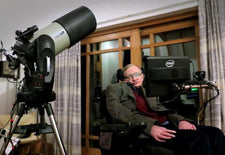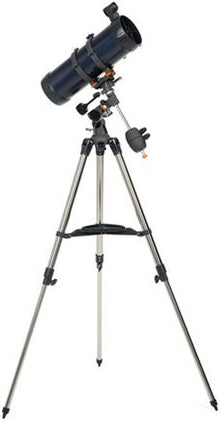Understanding Telescopes
May 4, 2015
Purchasing a new telescope can be baffling, especially for the first timer. And most of us are left wondering, so which telescope is for me? Understanding telescopes and their various accessories can go a long way in choosing the best one for you. Whether you are an amateur astronomer or veteran pathfinder, here are a few basic ground rules that will help you better identify the different types of telescopes and help you opt for the ideal one for you.
Aperture of a Telescope
A telescope's most important attribute is its aperture, which determines the brightness and sharpness of everything you see through your scope. Technically, this is the diameter of the main lens or mirror and as the aperture increases so does the details of the image you see. Depending on the aperture you will either see an open or a restricted field of view. For example a good 10" aperture scope shows sharper images than even a well-made 6" aperture telescope.
But since aperture is so important, many astronomers are misled into believing that getting the biggest aperture you can afford is the simplest way to choosing the best telescope for you. However in practice it's not so straightforward. If you make your decision based solely on the size of aperture, you might end up owning a massive telescope that sits in a corner gathering dust.
Ask yourself, where will I want to use my new telescope? If the answer is nearby in the backyard then having a large telescope will be of advantage to you. If you need to carry the telescope to darker skies away from city lights, you will definitely need something compact, yet powerful. And don't forget that you may have to assemble and set up your telescope in the dark making it even more difficult. And a scope that is too huge to carry outdoors and too long-drawn-out to set up, will rarely be of use.
Power or Magnification of a Telescope
Keeping aperture in mind, consider other important aspects like power and design before you make up your mind about the telescope you would like to purchase. Power is the magnification that the telescope can offer. This is a critical factor since it decides how close a view you can get of the space and planets. But it is not a decision making factor. You can make any telescope magnify at effectively any power you want by using different eyepieces.
An eyepiece is the small removable lens assembly you look into. Most telescopes come with several eyepieces and you can buy more separately. Remember to match the power of your eyepiece lens with the aperture of your scope for clear images. Using a very high power lens with a small-aperture telescope will show a highly magnified fuzz while with a large-aperture scope can show a meaningful image even at 200x or more. In either case, the lowest powers are the easiest to use, especially for beginners, and provide the most pleasant views.
Designs of Telescopes
Even among telescopes with the same aperture, some designs are more portable, others give sharper images while still others are more economical. There are three basic kinds of telescope to choose from depending on your specific requirements.
- Refracting telescope
- Reflecting telescope
- Catadioptric telescope
All 3 telescopes have the same light-gathering properties, despite their differences in size and weight. They also have a similar purpose, to collect light and bring it to a point of focus so it can be magnified and examined with an eyepiece, but each does it differently. Consequently, each type of telescope has its pros and cons, which you can match with your observing needs.
1. The Refracting Telescope or Refractor
Refracting telescopes are the most common form of the telescope - a long, thin tube where light passes in a straight line from the front objective lens directly to the eyepiece at the opposite end of the tube.
Advantages:
- Easy to use and consistent due to the simplicity of design.
- Good for distant terrestrial viewing
- Excellent for lunar, planetary and binary stargazing especially with larger apertures
- Sealed tube protects optics and reduces image degrading air currents
- Rugged, need little or no maintenance
Disadvantages:
- Generally have small apertures, typically 3 to 5 inches
- Less suited for viewing small and faint deep sky objects such as distant galaxies and nebulae
- Heavier, longer and bulkier than equivalent aperture reflectors and catadioptrics
- Limited practical usefulness
- Good-quality refractors cost more per inch of aperture than any other kind of telescope.
2. The Reflecting Telescope or Reflector
Reflecting telescopes use a huge concave parabolic mirror instead of a lens to gather and focus the light to a flat secondary mirror that in turn reflects the image out of an opening at the side of the main tube. You look through an eyepiece on the side of the tube up near the top.
Advantages:
- Easy to use and construct
- Excellent for faint deep sky objects such as remote galaxies, nebulae and star clusters because of their larger apertures for light gathering.
- Low in optical irregularities and deliver very bright images
- Reasonably compact and portable
- A reflector costs the least per inch of aperture compared to refractors and catadioptrics since mirrors can be produced at less cost than lenses
Disadvantages:
- Generally, not suited for terrestrial applications
- Slight light loss due to secondary obstruction when compared with refractors
- The tube is open to the air, which means dust on the optics even if the tube is kept under wraps
- Reflectors may require a little more care and maintenance
3. Catadioptric Telescope
Catadioptric telescopes use a combination of mirrors and lenses to fold the optics and form an image. Catadioptrics are the most popular type of instrument, with the most modern design, marketed throughout the world in 3 ?" and larger apertures. There are two popular designs, the Schmidt-Cassegrain and the Maksutov-Cassegrain.
In the Schmidt-Cassegrain, light enters through a thin aspheric Schmidt correcting lens, then strikes the spherical primary mirror and is reflected back up the tube to be intercepted by a small secondary mirror. The mirror then reflects the light out an opening in the rear of the instrument where the image is formed at the eyepiece.
Advantages:
- Most versatile type of telescope
- Best near focus capability of any type telescope
- First-rate for deep sky observing or astrophotography with fast films or CCD's
- Excellent for lunar, planetary and binary star observing plus terrestrial viewing and photography
- Closed tube design reduces image degrading air currents
- Compact and durable
Disadvantages:
- More expensive than reflectors of equal aperture
- Its appearance may not be suited to everybody's taste
- Slight light loss due to secondary mirror obstruction compared to refractors
The Maksutov-Cassegrain telescope design has basically the same advantages and disadvantages as the Schmidt. It uses a thick meniscus-correcting lens with a strong curvature and a secondary mirror that is usually an aluminized spot on the corrector. The Maksutov secondary mirror is typically smaller than the Schmidt's giving it slightly better resolution for planetary observing.
However, the Maksutov is heavier than the Schmidt and because of the thick correcting lens, it takes a long time to reach thermal stability at night in larger apertures. The Maksutov optical design typically is easier to make but requires more material for the corrector lens than the Schmidt Cassegrain.
Telescope Mountings
Now that you have learned about aperture, power and the different types of telescopes, let us discuss an often overlooked but very important aspect of using a telescope - the mountings. Remember that shaky view is all it takes to kill your enthusiasm! And a good mount can enhance your views. There are two basic telescope mountings:
- The equatorial
- The altazimuth
An Equatorial mount is designed so you can easily track the motion of the sky as the Earth turns and its motions indicate celestial north south and east west in the eyepiece. This is a great help when you're trying to find your way among the stars with a map. The Altazimuth mounts are simpler and just swing up, down, left and right. You have to move the scope along every so often to follow the stars, moons and planets. An altazimuth mount is both cheaper and lighter for the same degree of stability, advantages that are offered by an equatorial mount design.
You and your telescope
Whichever telescope you pick, choose one that will meet your precise needs and hobbies. The planets, the Moon, and close stars require high power, good contrast, and sharp resolution, and if these are the objects of your attention, a refractor or reflector is probably the best bet. While very faint objects like galaxies and nebulae need a huge aperture and you should invest in a big reflector telescope to view these. And if you haven't specialized, an all-purpose midrange telescope should serve best, for example a 6" or 8" reflector or an 8" Schmidt-Cassegrain.



